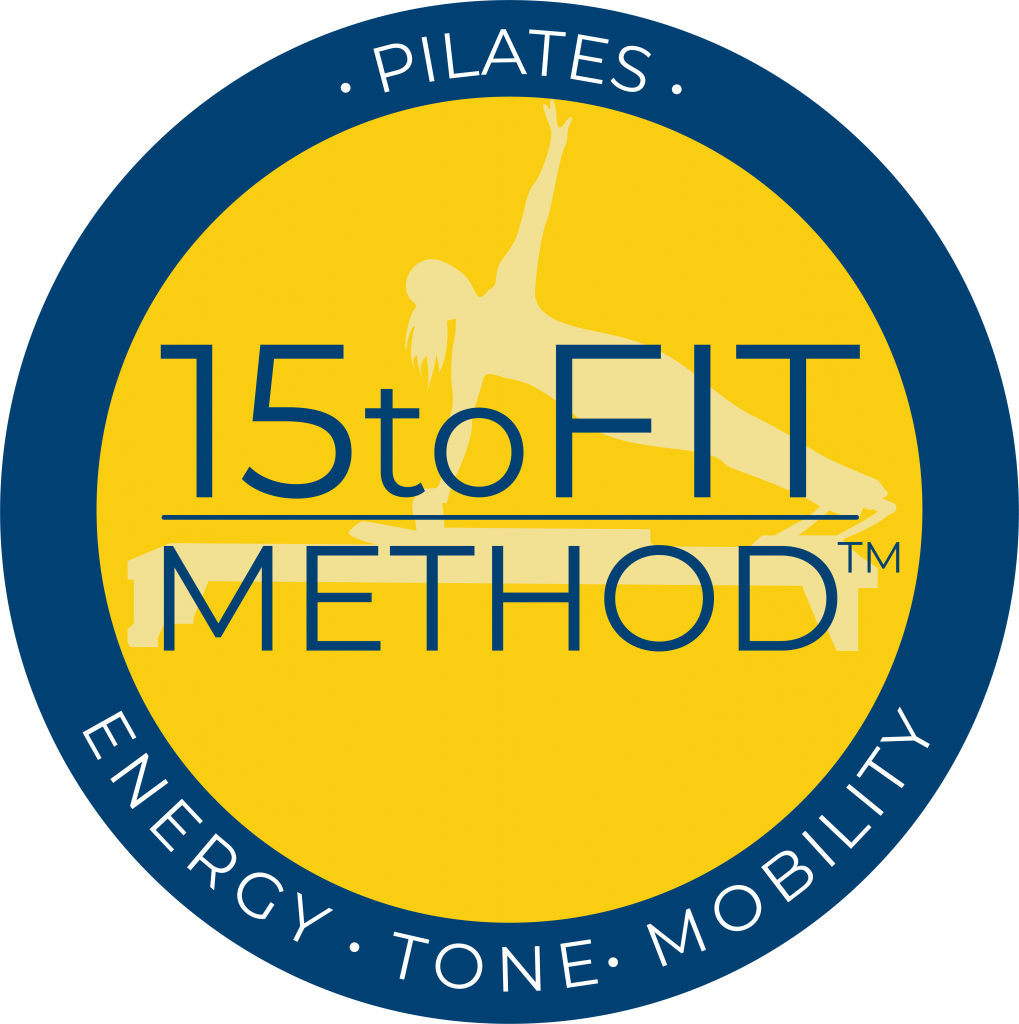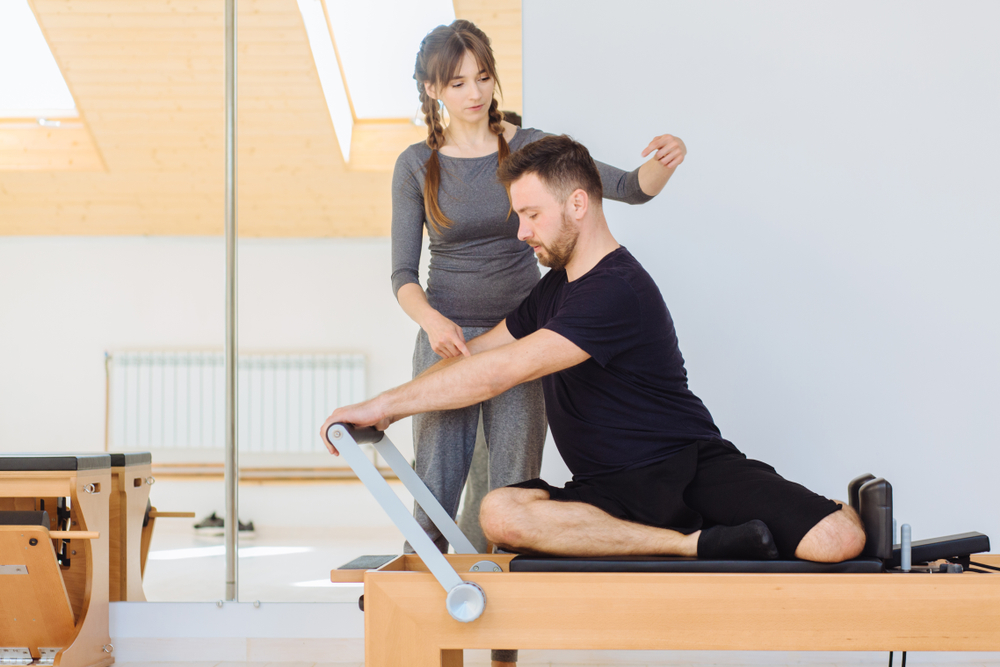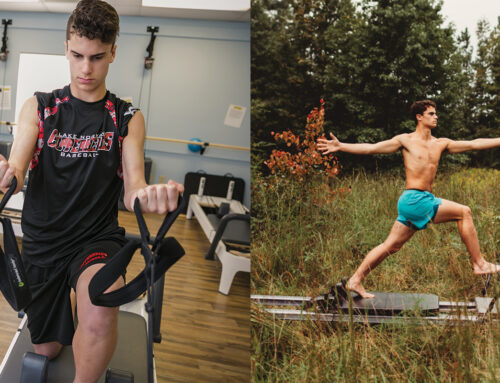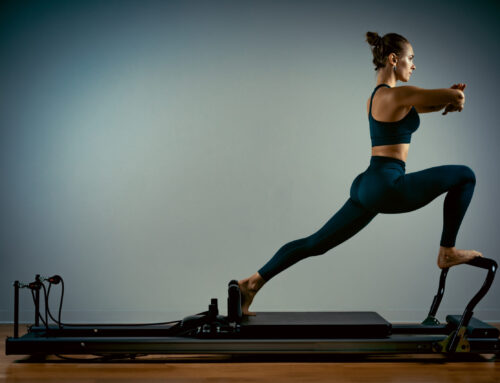This is exactly why I got into Pilates too. I was injured from years of gymnastics and fitness competitions. Pilates healed me! Also, I love it that Linda Royer is quoted here. She assisted me when I presented at NSCA in Indianapolis last year. She had a significant surgery that she recovered from so well, due to Pilates, that she heli -skied after! The kind of skiing where they helicopter you to the top of the mountain and you ski out. Amazing!
When you’re injured, recovering from a trauma, or experiencing any kind of pain, your workout is usually the first thing to take a back seat. In most cases, physical therapists and doctors will tell you to pause your running routine, skip Spin class, ditch the boot camps, and cool it with exercise — except Pilates. Andrea Speir, founder and master trainer at SPEIR Pilates, knows this firsthand.
“I tore my meniscus,” Speir told POPSUGAR. “That’s how I got into Pilates in the first place!” The celebrity trainer has become a Pilates icon, but it wasn’t always her exercise of choice — she was a dancer and track and field athlete. In fact, it wasn’t until she was prescribed a Pilates regimen by her physical therapist — with a goal of getting back on stage — that she began to make it part of her routine. And as you may have gathered, that routine was transformational enough to change the course of her life.
“The aesthetic side of Pilates — wanting to look a certain way — came after its original base of rehabilitating people’s bodies. The base of it is all therapy.”
And she’s not alone. More and more men and women are turning to this exercise not just as a way to lose weight and feel strong but as a full-blown rehabilitation program — oftentimes as ordered by a doctor or physical therapist. In fact, this workout can help you prevent injuries before they even happen . . . let’s get into how all of this works.
Why Do Physical Therapists Prescribe Pilates?
Who better to ask about prescribing Pilates for physical therapy than a physical therapist who also happens to be a master trainer of Pilates? (We’ll help you out: the answer is no one.) Physical therapist and Pilates Balanced Body Master Instructor Lindy D. Royer, PT, PMA-CPT, told POPSUGAR, “The Pilates environment is a natural fit for rehabilitation and physical therapy,” primarily because of its flexibility to meet the patient wherever they are in their recovery journey, “no matter what their current condition or ultimate goal.”
Therapists have seen massive success through using Pilates for rehab. “We have many clients who were told they would need surgery, particularly to treat neck or back issues,” Royer said. “These clients are now participating in Pilates classes two to three times a week and have resumed enjoying their activities with minimal discomfort.”
Royer described two patients — one is a woman in her 60s who was told she needed a spinal fusion and chose to “explore Pilates-based PT before committing to the surgery.” This patient ended up not needing the surgery, and Royer said that “several years later, [she] is thriving. She and her husband travel, hike, play golf together, and enjoy spending time with their grandchildren. She continues to come to classes, improving her alignment, movement, and strength, and has become a great friend to our practice and a wonderful advocate for the benefits of Pilates.”
Another one of Royer’s patients had already received a lumbar fusion many years ago but still had severe chronic pain and dysfunction that interfered with daily life and prevented her from going back to work — and she was ready to go on disability. “She had been told by other health providers, including a physical therapist, that she was ‘too broken’ to try Pilates,” Royer said, but after giving it a chance anyway, she not only healed herself, but she also ended up becoming a Pilates instructor herself. We’re not crying, you’re crying!
Pilates Was Created For Rehab
While a “Pilates body” might be the MO for some people signing up now, that wasn’t its original purpose. “Joseph Pilates put [Pilates] together as a physical therapy in a way,” Speir said. “It’s based on working your body in proper form and strengthening all the intricate, tiny muscles, as well as bigger ones. The aesthetic side of [Pilates] — wanting to look a certain way — came after its original base of rehabilitating people’s bodies — that [rehabilitation] was its whole purpose. The base of it is all therapy.”
The long, lean, svelte, and sculpted body just happened to be a lovely side effect of doing Pilates as a form of rehab. “People started doing Pilates for physical therapy, and it became huge with dancers back when Joseph Pilates had a studio in New York,” Speir said. “They realized how much stronger and healthier their bodies got from the exercises, and more people started doing it. They’ve got a torn meniscus, they’ve got a herniated disc . . . they start doing Pilates and then they got the bonus that their bodies looked amazing. They realized you can look good on top of rehabilitating your body.”
“They’ve got a torn meniscus, they’ve got a herniated disc . . . they start doing Pilates and then they got the bonus that their bodies looked amazing.”
So why does this workout take the cake over all others for therapeutic purposes? “The beauty of the full Pilates environment is that the apparatus and props can be used very effectively to support, assist, and facilitate movement so the patient can learn or relearn optimal movement in a safe way,” Royer said.
There are so many facets of Pilates that every single thing can be customized and tailored to a specific person’s body, needs, and injury. “In a fully equipped Pilates studio or clinic, mat work is not our only tool,” Royer said. She described support movement in “assistive, gravity-friendly positions” as well as challenging work for “training strength, balance coordination, speed, function, and endurance for even the most advanced patients.”
What’s more is that as the patient changes and progresses, the workout does too. “At any point along this path, we can adjust the support or challenge to make the process very specific to each individual. We are all uniquely designed, and the wonderful thing about Pilates is that it can be adapted creatively to match the individuality of the patient and meet their needs more precisely.”
Physical and Emotional Therapy
If you’ve ever dealt with an injury, you know that it not only can be physically traumatizing but quite emotionally traumatizing as well. There’s a significant level of anxiety that can come from a physical injury. We spoke with Michelle Lee, a POPSUGAR employee who has suffered from two herniated discs and turned to Pilates as a form of rehabilitation — both for the core strength and pain relief andthe respite from the mental anguish that can come with a hurt back.
Sara Grout, master trainer for Club Pilates, told us that Pilates can actually help to activate the parasympathetic nervous system while also “toning down the hyperactivity of our sympathetic nervous system.” Essentially, this exercise can help us chill out and manage anxiety, physiologically. “Most of us spend our days in ‘fight or flight’ mode: We rush from appointment to appointment, we fight our way through traffic, we have to get the kids off to school in time, and we overfuel ourselves on caffeine and/or sugar.” OK, who’s spying on us?! But for real — she has a serious point.
“When we can switch gears and activate our parasympathetic nervous system (our rest, digest, reparation, and recovery mode), our body can now heal, grow stronger, detoxify, and even lose extra weight,” Grout said. “During a reformer workout, footwork performed lying on our backs is often used to warm up the body and prepare it for movement where the focus is on proper alignment of the pelvis and spine, while focusing on the breath. By performing movement in this position while bringing intention to the breath, we automatically shift our bodies into the rest and repair mode, which is why you’ll leave a Pilates class feeling refreshed and reenergized.”
You know that feeling you get from deep breathing in yoga or meditation? Pilates has that too. Fun fact: “Joseph Pilates described the breath as ‘an internal shower for the body,'” according to Grout.
What to Keep in Mind When You’re Injured
So let’s say you’ve torn your ACL, herniated a disc, or just had shoulder surgery — don’t just jump into a group Pilates class! There’s a bit more to consider. Speir strongly recommends doing private sessions first. “If you’re doing private Pilates, you can do it with pretty much any injury,” she said, noting that this includes pregnancy — you’ll want special attention for prenatal Pilates. She said you can trust your instructor because “the anatomy side of [Pilates] training is humongous; usually the instructors got into teaching because they’ve had an injury themselves” and have realized the healing power of this exercise.
“If you’re doing private Pilates, you can do it with pretty much any injury.”
But with “one-on-one [training], you can do pretty much anything,” Speir said. “Pilates is going to be fantastic — especially for knee and back injuries.” Her only advisory for group classes would be to “make sure if it’s anything like a herniated disc or any stress injury, that the teacher is well-versed in whatever injury that is.”
How Can It Prevent Injuries If You’re Not Already Injured?
So you’re not injured, but you’re afraid of what could happen to your body through fitness — and from everyday life. Pilates is an incredible preventative practice, even if you’re not currently super active. “Many injuries occur because of an imbalance in the joints, connective tissues, or muscular system,” Royer said. So if you’re going about daily life but there’s something off in your alignment (fun fact: chances are you’re definitely off), then you’re super injury prone.
“As a preventative practice, Pilates gives us more bandwidth to absorb the inevitable knocks and bumps in life that could potentially by devastating,” Royer said. So that trip on a short ledge, that tumble on a lurching subway bus, or that missed step on the stairs? Your body will handle it so much better if you’ve been doing Pilates. “When we train the whole body and include appropriate motor control training via Pilates, we can react more quickly to the unexpected, giving us greater capacity for staying healthy, and the ability to recover more quickly if we do sustain an injury,” Royer said.
The mind-body connection is essential. Through the practice of Pilates, a patient becomes more in tune with their body and creates a better awareness that can eventually prevent injury. “Due to all the modifications I need [for my herniated discs], I’m still learning proper form, technique, and breathing,” said Lee, who has been doing Pilates for nine weeks now, as prescribed by her doctor and physical therapist. “But now I feel certain muscles (especially my core muscles) turning on or ‘firing’ that I haven’t felt before — nor knew existed!”
“[Pilates is] the perfect recovery and preventative tool.”
“In our normal everyday workouts, we’re often more concerned with where our heart rate is or how much we’re sweating,” Grout said. True. But in Pilates, you’re not going to sweat buckets or get a crazy heart rate number on your Fitbit or Apple Watch.
Instead, “we work on the connection between the mind and the body,” Grout said. “The idea is that by connecting your mind with your body, you can actually ‘turn on’ muscles that have been neglected or inhibited due to years of improper use and biomechanics. By retraining our faulty or imbalanced movement patterns during a Pilates class, we can begin to carry these new patterns into our daily lives, which means less pain, less risk of injury, and getting more out of every other activity we do, while possibly even growing a bit taller.”
Additionally, it’s one of the most low-impact, safest exercises you can do, “which makes Pilates accessible to everybody,” Grout said. “Pilates is designed as a low-impact activity so that not only are we taking pressure off of the joints, we are finding proper alignment (without the effect and pull of gravity) so that we can protect our joints in an even greater capacity, while training the body to move from this optimal alignment. This is a great time to decompress the spine and joints and move from a place that feels good. It’s the perfect recovery and preventative tool.”






